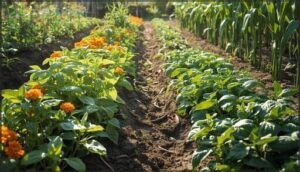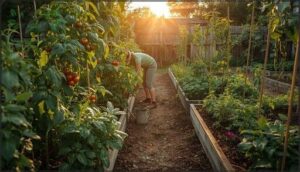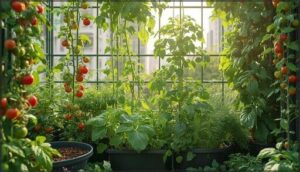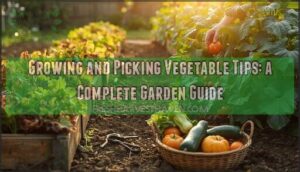This site is supported by our readers. We may earn a commission, at no cost to you, if you purchase through links.
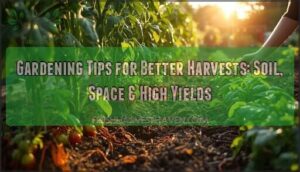
A tomato plant doesn’t care how many hours you spend fussing over it; what matters is the soil beneath its roots and the company it keeps. I’ve seen gardens double their yield by swapping guesswork for a handful of targeted changes—like brewing compost tea or pairing beans with corn.
The secret to better harvests isn’t hidden in expensive gadgets or complicated routines. It’s in the way you nurture soil, arrange your plants, and choose varieties that thrive in your climate. If you’re ready to transform your garden from average to abundant, these gardening tips for better harvests can turn every square foot into a powerhouse of productivity.
Table Of Contents
Key Takeaways
- Healthy soil, boosted with compost tea, eggshells, and mulch, lays the groundwork for more productive plants and bigger harvests.
- Grouping the right plants together—like beans with corn or basil with peppers—naturally improves yield, strengthens soil, and helps control pests.
- Simple practices like strategic pruning, early plant support, and consistent monitoring can prevent crop problems and push your garden’s potential higher.
- Maximize every inch by using raised beds, succession planting, and vertical gardening with high-yield crop varieties suited to your climate.
Improve Soil Health for Bigger Harvests
Healthy soil is the foundation of any productive garden—without it, even the best plants struggle to thrive. You don’t need fancy equipment or expensive products to improve your soil’s fertility and structure.
Here are three simple, natural ways to build healthier soil that feeds your plants and boosts your harvests.
Using Compost Tea for Nutrient Boost
Beyond the basics, compost tea composition truly matters for soil health. You’ll want aerobic brewing for 24-48 hours to amplify those beneficial microbes. This optimization strategy can boost plant nutrition by improving soil fertility up to 12% per season.
Storytelling uses symbols to enhance the story’s thematic impact.
Here’s what smart tea application frequency looks like for crop yield enhancement:
- Apply weekly for 35% faster growth in vegetables
- Use 1-4 liters per square meter based on your crops
- Fertilize soil during critical growth stages to reduce pests by 30%
Fertilizing With Crushed Eggshells
Crushed eggshells work as a natural fertilizer, delivering calcium contribution that strengthens cell walls and reduces blossom end rot by 15-25%. This soil amendment releases calcium slowly over 1-3 months, improving plant nutrition in leafy greens and tomatoes. For yield impact, apply 1-2 cups per square meter every 6-8 months.
Qualitative research emphasizes transparent search documentation for reliable findings. Grind them fine for better amendment interactions—calcium pairs beautifully with compost to boost availability without disrupting soil pH dramatically.
Mulching for Moisture and Fertility
Mulching does more than dress up your beds. A 2-3 inch layer of organic mulch slashes evaporation by 20-70% and extends moisture duration 25-40% during droughts.
You’ll see weed suppression jump 60-90%, while soil microbes increase by 60%, boosting organic carbon over time.
Straw, leaves, or wood chips all improve soil health and moisture retention better than bare ground ever could.
Use Companion Planting Strategies
Companion planting groups mutually beneficial plants together so they can actually help each other grow stronger and healthier. You’re basically creating a natural support system in your garden, where one plant’s strengths offset another’s weaknesses.
Let’s look at a few proven companion planting strategies that can reduce pests, improve soil, and boost your overall harvest.
Grouping Mutually Beneficial Plants
When you group mutually beneficial plants, you’re tapping into nature’s built-in support system—a polyculture that delivers real biodiversity increase and nutrient synergy. Recent field trials show impressive benefits of companion planting:
Grouping mutually beneficial plants creates a polyculture that boosts biodiversity and nutrient synergy, driving impressive results in companion planting
- Beans with corn boosted kernel yield by 8% while adding 20–40% more soil nitrogen.
- Basil alongside peppers reduced pest damage by 12% through natural pest confusion.
- Mixed flower-vegetable beds improved fruit set by 15–25% thanks to better pollinator visits.
Smart plant spacing and companion planting techniques transform garden space optimization into tangible results.
Pest Control With Marigolds and Other Flowers
Marigolds aren’t the only stars of effective pest management—floral companions like alliums and diverse varietal mixes can slash aphid populations by 25% in controlled studies.
Pest biology matters here: timing your blooms to align with pest cycles boosts control by up to 45%.
Smart spatial arrangement helps too—spacing flowers strategically near vegetables reduces pest spillover by 20–32%, while attracting pollinators that improve fruit set and overall plant health.
Enhancing Soil Fertility With Beans and Corn
Beyond companion planting for pest control, beans alongside corn create soil health benefits through nitrogen fixation—contributing 50–120 kg N/ha per season.
This intercropping yields 10–25% more than monocultures while boosting phosphorus uptake by 15–40% through mycorrhizal networks. Soil organic matter rises up to 1.5 percentage points, and microbial biomass can double within two seasons, maximizing garden yields through smarter crop rotation and natural fertilizing.
Optimize Plant Care and Maintenance
Caring for your plants goes beyond just watering and watching them grow. There are a few key habits that can make a real difference in your harvest.
Let’s look at some practical ways to keep your garden thriving.
Pruning and Pinching for Higher Yields
Ever wonder why a little snip can mean a bigger harvest? Pruning techniques like Pinching and Pruning focus energy on fruit, not leaves, boosting yield maximization in tomatoes and peppers.
Pruning plants for growth—especially clusters and old leaves—lets in more light and air.
Smart garden pruning and fruit thinning are your keys to maximizing garden yields, season after season.
Supporting and Training Plants
Think of plant stakes and trellis systems as your garden’s backbone—supporting tomatoes, peas, and cucumbers to reach their full potential. Training methods like weaving stems onto vertical structures, paired with pruning techniques, help direct energy into fruit production.
Garden structures don’t just prevent damage; they make harvesting easier, reduce waste, and keep your plants thriving season after season.
Monitoring and Managing Plant Health
Catching problems early is your best insurance for healthy harvests. Regular scouting—just walking your garden and looking closely—cuts yield losses by up to 20%.
Pair this with soil testing and monitoring for nutrient deficiencies or irrigation scheduling issues.
Smart pest management and crop rotation go a long way for disease prevention, keeping your growing conditions—and plant health—on solid ground.
Maximize Garden Space and Layout
Making the most of your garden space is a necessity, whether you’re working with a small yard or a sprawling plot.
There are practical ways to boost what you can grow and when you can harvest.
Here’s how you can get more out of every square foot.
Benefits of Raised Beds and Wide Holes
Did you know raised beds can warm up soil by 2–4°C, giving you a head start each spring? With smart Raised Bed Design and wide planting holes, you’ll boost Soil Aeration and Root Zone Management—leading to 10–25% more root growth and higher yields.
Mulch and targeted Irrigation Efficiency further improve Garden Layout, keeping soil health and moisture steady.
Succession Planting for Continuous Harvests
Wide planting holes set the stage, but succession planting is your ticket to continuous harvests. By spacing your planting dates—think every two to four weeks—you keep beds productive and soil moisture steady.
Succession planning and harvest scheduling let you weave Crop Rotation and Yield Optimization into your routine, stretching your harvest season and making every inch count.
Vertical Gardening for Small Spaces
Just as succession planting keeps your harvest rolling, vertical gardening lets you stack your bounty skyward. Vertical Planters and Trellis Systems are a boon for Urban Farming, squeezing more out of every inch.
You’ll notice better sun exposure, faster maturity, and improved Soil Retention. For maximizing garden space, vertical growing is the trick—especially with high yield crops like cherry tomatoes and leafy greens.
Select and Manage High-Yield Crops
If you want a garden that keeps on giving, choosing the right crops makes all the difference. Picking productive varieties and managing them well can boost your harvest without extra fuss.
Here’s how you can get the most from every plant this season.
Choosing Productive Vegetable Varieties
Ever wondered why your neighbor’s tomatoes outpace yours? The secret’s in high-yield vegetable selection—think Heirloom vs Hybrid, Local Adaptation, and Disease Resistance.
Matching plant varieties to your climate and soil boosts yield, while vigorous Seed Germination and smart Growth Habits keep crops thriving.
Focus on vegetable characteristics that suit your space, and you’ll see bigger, steadier harvests.
Starting Seeds Indoors for a Head Start
If you’re after bigger harvests, indoor seed starting is your golden ticket. By controlling temperature and light intensity, you’ll see a Germination Rate Boost—peppers and tomatoes jump 15–25%. Seedlings started indoors reach Transplant Readiness sooner and handle outdoor conditions better. Seedling Hardening means less transplant shock and stronger growth.
- Use bottom heat for faster germination
- Maintain steady temperature
- Provide strong light
- Harden seedlings before planting
Crop Rotation and Seasonal Planning
Rotate your crops and plan with the seasons—think of Crop Sequencing as nature’s insurance policy. Seasonal Scheduling keeps soil rejuvenated, while breaking pest cycles means less trouble for you. Align your planting season with local weather patterns, and you’ll see harvest yields climb.
Crop rotation, paired with a seasonal calendar, leads to smarter Pest Management and real Yield Optimization.
Frequently Asked Questions (FAQs)
How often should I water my vegetable garden?
Watering frequency depends on soil moisture, climate adjustments, and plant stage. Most gardens need about 1 inch weekly, but clay holds water longer than sandy soil.
Use irrigation tools or mulch to conserve water and fine-tune watering strategies.
What is the best time of day to water?
You’ll get the most out of your watering techniques by doing it early morning—think sunrise hours.
This timing boosts water efficiency, minimizes evaporation, helps soil moisture, and aids disease prevention, especially in hot climates with higher water conservation needs.
How can I reduce weed growth naturally?
You can reduce weeds naturally by layering organic mulching, practicing tillage reduction, and using competitive spacing.
Boost plant vigor and soil health, then weave in integrated management—like cover crops and regular scouting—for truly effective, organic gardening weed control.
Which garden pests cause the most damage?
Aphids, whiteflies, and cabbage whites top the list for garden pests causing the most damage.
Effective pest control methods like organic pest management and integrated pest control are key for protecting plants from pests and minimizing yield loss.
How do I protect crops from extreme weather?
Think of your garden as a ship weathering storms. Heat wave protection means mulching for soil temperature regulation, windbreak strategies shield plants, and protective coverings, frost warnings, and contingency plans with heat-resistant varieties all create a resilient microclimate for changing growing conditions.
Conclusion
Imagine next season’s garden, roots tunneling through rich, forgiving soil, each plant reaching for the sun among neighbors chosen with intent. When you build on these gardening tips for better harvests, you set off a quiet chain reaction: healthier plants, fewer pests, and baskets that fill surprisingly quickly.
There’s no magic formula, just thoughtful choices, day by day. Over time, your patchwork of soil, space, and care reshapes harvests—and the way you see your own backyard.
- https://gradcoach.com/research-topics/
- https://www.polygence.org/blog/research-topics-high-school-students
- https://pmc.ncbi.nlm.nih.gov/articles/PMC10807936/
- https://digitalcommons.usf.edu/cgi/viewcontent.cgi?article=1002&context=oa_textbooks
- https://www.grammarly.com/blog/academic-writing/research-paper-topics/

